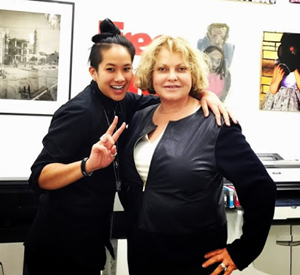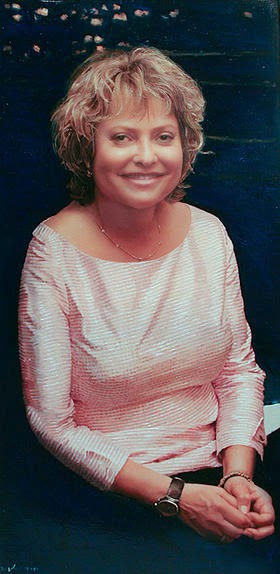
In 1990 Eileen Kaminsky began her journey into art collecting. Her passion for art turned into a passion for artists, and collecting became less an assemblage of works and more an interaction, a relationship, with artists. This inspired her to establish the Eileen S. Kaminsky Family Foundation.
In 1990 Eileen Kaminsky began her journey into art collecting. Her passion for art turned into a passion for artists, and collecting became less an assemblage of works and more an interaction, a relationship, with artists. This inspired her to establish the Eileen S. Kaminsky Family Foundation. Since 2009 the ESKFF has been committed to connecting art world practitioners – artists, curators, collectors, galleries, cultural institutions, and the public – by establishing exhibitions and various programs based on private contemporary art collections. In this way, the ESKFF makes it their mission to give access to the private collections that are usually out of the public’s reach. Eileen Kaminsky shares with Artdependence her love of art, the driving force throughout her 25 years of collecting.
Artdependence Magazine: How did you develop an interest in art? Were you raised in a family with strong interest in art?
Eileen Kaminsky: As a child my parents would throw us in the back seat of the station wagon on many rainy Sundays, and head for the Metropolitan Museum of Art. Nowadays when I enter the Met I swear I still smell wet wool.
There was so much to see and so many steps to climb. I recall trailing after my mother, who always headed first for the basement costume displays and then up to the old Masters and Impressionists. I remember the paintings being bigger than life, and then seeing prints of the some of the same paintings hanging in our home. I grew up surrounded by impressionists like Monet, Cezanne, and van Gogh. Always beautiful always present.
I live a blessed life. I studied art history in college; and in recent years I’ve been able to travel and see art around the world. I remember the impact of seeing a Rembrandt as a child, and then seeing the same painting restored years later. It helped me understand as a collector what damage the years can do to fine art and the importance of maintaining collections for generations to come.
Serving on the board of directors of Exit Art, HVCCA and the Friars Club, I made new contacts, was exposed to so many new and profoundly interesting artists and opportunities to help people. My mind was open to new ideas and different forms of expression.
Eileen and John Newsom, courtesy Eileen Kaminsky
AD: What was the first piece of art you collected?
EK: The first work of art I purchased was a lithograph by David Schluzz. It was a group of multi colored musicians in full joyous performance. It sat over our couch for many years, and I loved its celebration of life. It has been donated to a wonderful charity.
AD: Can you explain a bit about your collecting process and how it started; was it through a particular book, an art fair, a gallery, or maybe someone’s advice?
EK: When I began to collect art in earnest, I was lucky enough to meet the artist Yigal Ozeri, and his dealer Ran Levady. Because I fell in love with Yigal’s paintings, I began to seriously cultivate my personal collection.
Over the years with all that I have seen and learned my tastes have changed. I have been invited into the studios of many great young "emerging" artists. I was given an education on processes and the trials and tribulations of the artist in America. I started to see with the eye of the creator, seeing the mark of the artist, the touch of the paint, the light, color, composition, texture, and so much more.
At the fair with AYAKAMAY, "Mimikaki" performance, LICHT FELD GALLERY. Courtesy Eileen Kaminsky
AD: In 2009 you started the Eileen S. Kaminsky Family Foundation. Does running a foundation give you a different approach to collecting? Does the ESKFF, or yourself have personal ties to the artists you collect? Do you feel there’s been an evolution / development in what you choose to collect?
EK: I have a very personal tie to Yigal Ozeri. I have traveled to Texas, Los Angeles, San Francisco, and Florida, where I added to my collection with the works of the artists I met through Yigal and his then US dealer Mike Weiss.
As Yigal’s career and contacts grew, I followed him to Hong Kong, Italy, France, Amsterdam, Spain and Israel. My knowledge, love of art and my collection grew. I bought what I loved but meeting the artists and visiting their studios certainly enhanced my purchase decisions.
We would also visit other collectors who lived with their art. On one trip to Paris I was taken by the ceiling art. When I arrived home I had paintings put on my ceiling and loved waking up to see my lovely daughter's images painted by Stanley Mouse from California.
I was encouraged to start a foundation for the arts. And we created the website with the purpose of having a museum without walls. The collection is now shown online at ESKFF.com.
We travel the world in the name of art. Courtesy Eileen Kaminsky
AD: In the ESKFF you work with a board of collectors - do they advise on which artists to collect? Does it mean that you have less freedom in collecting, as in the past you decided on your own and now they are also involved in the process? Can you give an example?
EK: The ESKFF’s collection is divided into works that I own personally and ESKFF works that have been produced in the residency or donated to the foundation. That is clearly defined, as the works are posted online and packaged for storage.
No foundation funds are used to purchase work, store or restore it. So I can select and collect what I like. Yigal Ozeri will frequently take me on studio visits and art walking tours where he will teach me things and point out works that would enhance the collection. Once I buy an artist's work I like to follow the artist. I will look for him or her at art fairs, which is a great way to see a variety of art. I will look for their work in auctions and online. And when I find a new work that enhances the collection, I buy it.
As an example, I buy works from Erik Formoe on Facebook. It is just too hard to travel to Norway. I was introduced to his work during Art|Basel Miami Beach. I now know and understand his technique, so I can continue to add his new work to my collection no matter how I find it.
Norway artist Erik Formoe. Courtesy Eileen Kaminsky
AD: What art medium do you like the most: painting, photography, video, or sculpture?
EK: I love art of all kinds, but still prefer paintings. I also like a little mystery. As an example, I made a recent purchase: "Night Swim", by Christian Vincent, a Los Angeles artist. It’s a large work showing the back of a woman looking at a lake house through the trees. Lots of questions come to mind… Who is she? What is she looking at? Where is this? Every time I look at the work all the questions come back.
I am also very selective. Now I check the materials: no acid paper, no scotch tape, as I want the work to last forever. I also have to consider shipping costs. I bought a large painting in Germany, and the shipping cost almost as much as the work. You really have to love a work of art to pay double.
Ran Levady and Yigal Ozeri and me traveling. Courtesy Eileen Kaminsky
AD: What more do you hope to accomplish with the ESKFF?
EK: It’s amazing that it’s been only six short years since Yigal Ozeri met Eugene Lemay and truly began to develop MANA Fine Arts. It gave ESKFF the opportunity to have an exhibition space to show works from our collections rather than just one particular artist. On an event day we can get 3000 people to visiting ESKFF when all the other MANA openings the run concurrently to our events.
As a collector I also kept meeting artists who needed a studio, or help to reach the next step in their career. Buying a painting from them was only a short-term help. After my first year at MANA, visiting the artists who had studios there and being exposed to all of the wonderful space, I approached my board to rent a space at MANA to start a residency program for emerging and mid-career artists.
So now my collecting approach has changed. The residency changed my focus: from the art to the artist. While I still collect some works of art, I also now collect artists. It has been a terrific learning experience. We went from 4 artists to 6 and now 8 participating in two-to-three-month residencies. At the end of their residencies the artists don't want to leave, but we have candidates lined up to take their space and I wish I could help them all.
Madrid at the museum. Courtesy Eileen Kaminsky
The current 3-month group is supervised by the Witches of Bushwick. The presentation includes lots of video, fabrics, paint, glitter, and woodworking. So much energy and fun!
In July we have our first international group flying in for a one-month experience. In August we have a student program where a high school student pairs with a college student. We also reserve one space for MANA employees, since so many of them are artists. MANA has given so much to ESKFF this is one way we can give back.
For the future I have asked my board to have a permanent space at MANA to display the works of Yigal Ozeri, Eugene Lemay, and the other artists of the collection. We have so many guest exhibitions there is just no time to present my personal collection.
Founder and creative director of Witches of Bushwick, Christine Tran & Eileen Kaminsky. Courtesy Eileen Kaminsky
 |
| Portrait of Eileen by Yigal Ozeri |
AD: Can you comment on your goals and future vision for ESKFF?
EK: My dream is to continue to expand the ESKFF residency program at MANA, helping more talented artists to develop their personal artistic mediums. If future funding allows I would like to expand globally, and sponsor international talent from underprivileged countries.
However like all foundations, our future has a great deal to do with raising money via funding opportunities. Over the past three years we’ve hosted annual auction fundraisers to help support the foundation artists and grow the residency space. These auctions were possible because of the generous donations from artists, galleries and of course ESKFF residents. Unfortunately the auctions do not make ESKFF self-sufficient. We are now beginning to research grants to make sure ESKFF’s heritage of supporting artists will survive for future generations.
AD: Thank you, Eileen, and good luck!

ArtDependence Magazine is an international magazine covering all spheres of contemporary art, as well as modern and classical art.
ArtDependence features the latest art news, highlighting interviews with today’s most influential artists, galleries, curators, collectors, fair directors and individuals at the axis of the arts.
The magazine also covers series of articles and reviews on critical art events, new publications and other foremost happenings in the art world.
If you would like to submit events or editorial content to ArtDependence Magazine, please feel free to reach the magazine via the contact page.